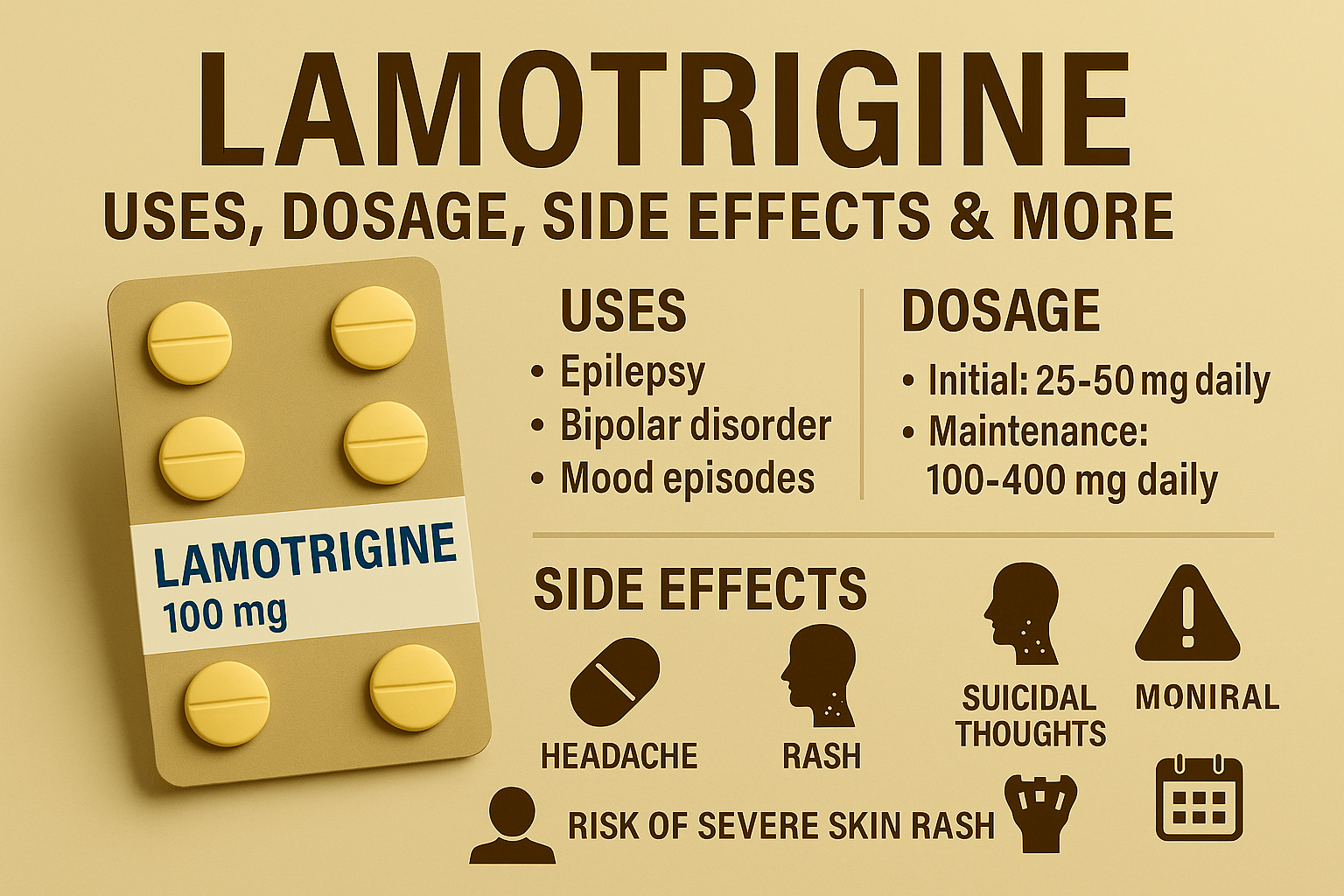Lamotrigine (Lamictal): Uses, Dosing, Side Effects, Interactions & FAQs
GET HELP TODAY!
100% Confidentiality Guaranteed


Lamotrigine (Lamictal) Overview at a Glance
What is Lamotrigine used for?
It treats epilepsy (seizures) and helps prevent future mood episodes in bipolar I disorder.
How is Lamotrigine taken?
Dosing starts low (25–50 mg daily) and gradually increases to 100–400 mg daily to reduce rash risk.
What are the most serious risks?
Severe skin rash (Stevens–Johnson syndrome), aseptic meningitis, and rare blood or heart complications.
Does Lamotrigine affect weight?
Most people remain weight-neutral, though some may experience slight weight loss.
What key interactions should you know?
Estrogen birth control pills, valproate, enzyme-inducing seizure drugs, and alcohol can all change how lamotrigine works.
Is it safe in pregnancy and breastfeeding?
Often considered a reasonable option when needed, but doses may require adjustment—discuss with your clinician.
What is Lamotrigine?
Lamotrigine is a prescription anticonvulsant and mood‑stabilizing medicine used in epilepsy and for maintenance treatment in bipolar I disorder. You may see it sold under brand names such as Lamictal (immediate‑release, ODT, chewable) and Lamictal XR (extended‑release). In epilepsy, it can be used alone or with other anti‑seizure drugs; in bipolar I disorder, it helps delay future mood episodes, especially depressive episodes, but it is not for acute mania.
How lamotrigine works
Lamotrigine dampens overactive nerve firing by modulating voltage‑gated sodium channels and influencing excitatory neurotransmission (like glutamate). The net effect is fewer seizures and greater mood stability over time.










What lamotrigine treats
Epilepsy: focal (partial) seizures, primary generalized tonic‑clonic seizures, and seizures associated with Lennox‑Gastaut syndrome; can be used as monotherapy or adjunct depending on age/formulation.
Bipolar I disorder (maintenance): reduces risk and delays time to new depressive and manic/hypomanic episodes; strongest effect is usually on preventing depression.
Serious risks & the boxed warning (read this first)
Skin reactions: Lamotrigine can cause serious rashes, including Stevens–Johnson syndrome (SJS) and toxic epidermal necrolysis (TEN). Risk rises if (a) you start at too high a dose, (b) increase doses too quickly, or (c) take it with valproate. Rash risk is higher in children than adults. Stop the drug and seek urgent care at the first sign of rashunless a clinician has clearly determined it is not drug‑related.
Other rare but important warnings include:
Hemophagocytic lymphohistiocytosis (HLH): fever, rash, enlarged nodes, organ dysfunction—requires urgent evaluation.
Aseptic meningitis: headache, fever, neck stiffness, photophobia, nausea—seek medical care.
Cardiac conduction concerns: caution in people with certain heart rhythm disorders; discuss risks vs benefits with your clinician.

Dosing & titration (why “start low, go slow” matters)
Lamotrigine must be titrated slowly to reduce rash risk. Dosing varies by condition, age, and concomitant medicines.
Typical adult bipolar maintenance titration (IR), if not on valproate or enzyme inducers:
Weeks 1–2: 25 mg once daily
Weeks 3–4: 50 mg once daily
Week 5: 100 mg/day (once daily or divided)
Week 6+: 200 mg/day target (some need 100–400 mg/day)
Do not exceed the recommended rate of increase.
If taking valproate (valproic acid/divalproex): valproate inhibits lamotrigine metabolism; doses start lower and rise more slowly (e.g., 25 mg every other day for 2 weeks, then 25 mg daily for 2 weeks, then gradual increases; typical maintenance often 100 mg/day).
If taking enzyme‑inducing AEDs (e.g., carbamazepine, phenytoin, phenobarbital, primidone): these increaselamotrigine clearance, so initial and maintenance doses are higher (e.g., starting 50 mg/day, then 100 mg/day, then gradual increases to higher targets per prescriber).
Extended‑release (XR) is typically once daily; chewable/ODT formats exist for flexibility. Never rush titration; a slow climb is safer.
Interactions (birth control, inducers/inhibitors, alcohol)
Estrogen‑containing oral contraceptives (OCs) increase lamotrigine clearance, often lowering lamotrigine levels. Many patients need up to a 2‑fold increase in maintenance dose when starting OCs; levels can bounce higher during the pill‑free week. If you start or stop OCs, talk to your prescriber so they can adjust dosing and monitor for dizziness, ataxia, diplopia.
Valproate raises lamotrigine levels; enzyme inducers (carbamazepine, phenytoin, phenobarbital, primidone, rifampin, some protease inhibitors) lower them; doses must be adjusted accordingly.
Alcohol and sedatives can worsen drowsiness, balance, and reaction time—be cautious.
Side effects: common vs serious
Common: headache, dizziness, blurred/double vision, nausea/vomiting, sleep issues, back pain, fatigue. These often ease with time or dose adjustments.
Serious: the boxed rash, aseptic meningitis, blood dyscrasias, HLH, and cardiac arrhythmias in susceptible individuals. Seek care for rash, fever, stiff neck, yellowing skin/eyes, unusual bleeding, chest pain, or fainting.
Weight change on lamotrigine (gain vs loss)
Weight is a high‑priority concern for many taking mood stabilizers. Unlike several comparators, lamotrigine is generally weight‑neutral and can be associated with modest weight loss in some groups:
In bipolar disorder trials, lamotrigine weight change resembled placebo over one year, while lithium was associated with weight gain.
In obese bipolar patients, lamotrigine use was associated with weight loss, whereas lithium showed gain.
An older neurology cohort comparing valproate vs lamotrigine showed significantly more gain with valproate.
Major clinical sources also note lamotrigine stands out from mood stabilizers for minimal weight impact.
Bottom line: If “lamotrigine weight gain” is your worry, the balance of evidence suggests low risk of gain, with neutral to slight loss most common. Individual responses vary; track weight, appetite, and activity, and discuss changes with your prescriber.
Pregnancy, breastfeeding & birth control—practical guidance
Pregnancy: Decisions are individualized. Many clinicians consider lamotrigine a reasonable mood‑stabilizing option in pregnancy given its overall reproductive safety profile, though data are not identical across sources. Work closely with your prescriber to balance relapse prevention and fetal risk; doses may need adjustment as pregnancy progresses.
Breastfeeding: Lamotrigine passes into breastmilk. Most studies/registries suggest no adverse effect on infant growth/development in monotherapy; monitor the baby for sedation or feeding issues and coordinate with pediatric care.
Authoritative patient sources (e.g., MotherToBaby, NHS) offer practical counseling and monitoring advice; review these with your clinician.
Birth control: As above, estrogen OCs lower lamotrigine levels (dose often needs to increase); levels can swing during the pill‑free week. Plan dose changes with your prescriber before starting/stopping hormonal contraception.
More Time. More Joy. More You. Start Now.
WE ACCEPT MOST INSURANCES







Alternatives & comparisons (and the “best antidepressant with lamotrigine” question)
For bipolar mood stabilization, common alternatives include lithium, valproate/divalproex, and carbamazepine; several atypical antipsychotics are also used depending on phase and symptoms. Among these, lamotrigine is notable for minimal weight effect, while many others can promote gain. Choice depends on episode polarity, prior response, comorbidities, and tolerability.
“Best antidepressant with lamotrigine?” There isn’t a one‑size‑fits‑all “best.” In bipolar disorder, adding antidepressants must be weighed carefully to avoid manic switching; guidelines often prioritize optimizing mood stabilizers/atypicals first. Any combination should be clinician‑directed, taking into account interactions and individual risk. (For seizure disorders with comorbid depression, the calculus differs; coordinate neurology and psychiatry care.)
Who should avoid or use caution
History of severe rash to lamotrigine/antiepileptics
Significant heart rhythm disorders (discuss risk; may not be ideal)
Hepatic/renal impairment: may require dosing adjustments and slower titration.
Pediatrics: rash risk is higher in children; follow specialist guidance and labeled age/indication limits.
How to take lamotrigine well
Adherence: take it daily as prescribed; don’t stop abruptly (seizure risk; mood relapse).
Missed dose: take when remembered unless close to the next dose; don’t double up.
Form matters: XR must be swallowed whole; ODTs go on the tongue; chewables can be chewed or dispersed in a small amount of liquid.
Monitoring: report rash immediately; watch for new/worsening mood changes or signs of infection/bleeding.
Freedom Starts Here. Take Back Your Life Today.
Same-Day Admissions in Austin Available.
Lamotrigine FAQs: Uses, Dosage, Side Effects, Weight, Pregnancy & Interactions
How can you lose weight while taking bipolar medications?
Weight management often involves diet, physical activity, and monitoring medication side effects. Some bipolar medications cause weight gain, but lamotrigine is generally weight-neutral.
What depression medication is linked with weight loss?
Certain antidepressants, like bupropion, may be associated with modest weight loss. Always discuss medication choices with your provider before making changes.
What bipolar medication causes weight loss?
Lamotrigine is one of the few mood stabilizers associated with weight neutrality or slight weight loss in some patients.
Can you lose weight on lamotrigine?
Yes, some people lose weight or maintain their weight while taking lamotrigine, though individual results vary.
Can you take lamotrigine and venlafaxine together?
These can sometimes be prescribed together for certain conditions, but they may increase the risk of side effects. Always follow your doctor’s guidance.
Can lamotrigine cause nausea?
Yes, nausea is a common side effect, especially when first starting treatment. It often improves with time.
Can you take Abilify and Lamictal together?
Yes, they are sometimes used together in bipolar disorder treatment, but monitoring for interactions and side effects is important.
Does Lamictal cause diarrhea?
Diarrhea is a possible side effect, though less common. Report persistent gastrointestinal issues to your provider.
What are the most serious risks with lamotrigine?
Severe skin reactions such as Stevens-Johnson syndrome, along with rare conditions like aseptic meningitis and blood disorders, are the most serious risks.
Does lamotrigine interact with birth control?
Yes, estrogen-containing oral contraceptives can lower lamotrigine levels, requiring dose adjustments.
How Nova Recovery Center Can Help with Lamotrigine Addiction and Abuse
At Nova Recovery Center, we understand that lamotrigine misuse or dependency can deeply impact both physical and mental health. While lamotrigine is a valuable medication for epilepsy and bipolar disorder, using it outside of prescribed guidelines may lead to dangerous side effects, withdrawal issues, or patterns of abuse. Our comprehensive programs are designed to address not just the physical challenges of medication misuse, but also the underlying emotional and behavioral factors that contribute to it. We offer medically supported detox services, structured inpatient rehab and outpatient rehab (IOP), and individualized treatment plans tailored to each client’s unique needs. Our team provides evidence-based therapies alongside holistic approaches that promote healing for the mind, body, and spirit. With a focus on relapse prevention and long-term recovery, clients gain practical tools to maintain sobriety and stability. At Nova Recovery Center, we also offer family education and support groups to help loved ones understand the recovery journey. Whether someone is struggling with lamotrigine abuse alone or alongside other substances, we provide the structure and guidance needed for lasting recovery.
Get help today. Reach out now to start your path to healing.

